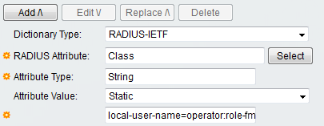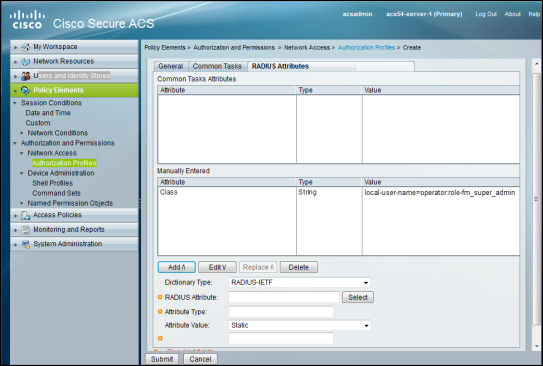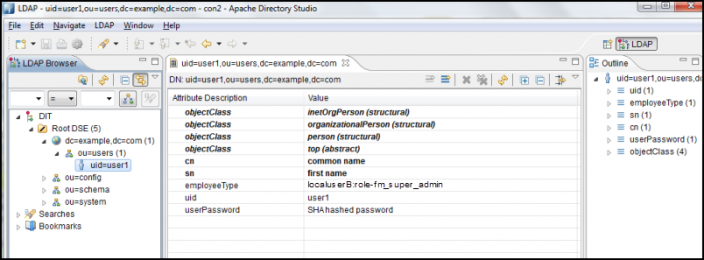Configure Roles in External Authentication Servers
This section describes how to set up RADIUS, TACACS+, and LDAP servers to work with GigaVUE nodes, including how to include a local user mapping attribute that the GigaVUE node can use to assign roles to an externally-authenticated user. Refer to the following sections for details:
Configure Cisco ACS: RADIUS Authentication
Use the following steps to configure Cisco ACS 5.x (RADIUS) to grant extra roles to externally authenticated users on the GigaVUE H Series node.
Enable Extra Roles for RADIUS on the GigaVUE Node
|
1.
|
Go to Settings > Authentication > RADIUS > Default Settings to enable the GigaVUE H Series node to accept extra roles in the response from the AAA server. |
Note: The extra role must match a role already configured on the GigaVUE H Series node/cluster.
Example of Assigning the Class Attribute in RADIUS Authorization Profile (ACS 5.x)
|
2.
|
Navigate to Policy Elements > Authorization and Permissions > Network Access > Authorization Profiles and click Create to add a new authorization profile. |
|
3.
|
Give the profile a name and description and click on the RADIUS Attributes tab. |
|
4.
|
Leave Dictionary Type set to RADIUS-IETF and click the Select button adjacent to the RADIUS Attribute field. |
|
5.
|
Select the Class attribute from the dialog that appears and click OK. |
|
6.
|
Leave the Attribute Type and Attribute Value fields at their default value (String and Static, respectively). |
|
7.
|
Supply the local user mapping and optional roles, as shown in the following figure: |

|
8.
|
Click the Add button to add this attribute to the authorization profile. |
|
9.
|
Assign this authorization profile to a group and populate it with GigaVUE users. |
Figure 1: Supplying the Class Field for RADIUS (ACS 5.x) shows these settings in a CiscoSecure ACS 5.x authorization profile.

|
Figure 14
|
Supplying the Class Field for RADIUS (ACS 5.x) |
Configure Cisco ACS: TACACS+ Authentication
Use the following steps to configure Cisco ACS 5.x (TACACS+) to grant extra roles to externally authenticated users on the GigaVUE H Series node.
Enable Extra Roles for TACACS+ on the GigaVUE H Series Node
|
1.
|
Go to Settings > Authentication > TACACS > Default Settings to enable the GigaVUE H Series node to accept extra roles in the response from the AAA server. |
Note: The extra role must match a role already configured on the GigaVUE node/cluster.
Example of Assign local-user-name to Shell Profile (ACS 5.x)
|
2.
|
Navigate to Policy Elements > Authorization and Permissions > Device Administration > Shell Profiles and click Create to add a new shell profile. |
|
3.
|
Give the profile a name and description in the General tab. |
|
4.
|
Click on the Custom Attributes tab. |
|
5.
|
Set the Attribute field to local-user-name. |
|
6.
|
Leave the Requirement and Attribute Value fields at their default value (Mandatory and Static, respectively). |
|
7.
|
Supply the local user mapping and optional roles, as shown in the following figure: |

|
8.
|
Click the Add to add this attribute to the shell profile. |
|
9.
|
Click Submit to finalize this shell profile. |
|
10.
|
Create Service Selection rules that will assign this shell profile to desired GigaVUE users. |
Configure LDAP Authentication
Use the following steps to configure an LDAP server (for example, Apache Directory Server) to grant extra roles to externally authenticated users on the GigaVUE H Series node.
|
1.
|
Enable Extra Roles for LDAP on the GigaVUE H Series. |
To enable the GigaVUE H Series node to accept extra roles in the response from the AAA server:
|
a.
|
Select Settings > Authentication > LDAP |
|
b.
|
Click Default Settings. |
|
c.
|
Set the Extra Roles field to Yes. |
Note: The extra role must match a role already configured on the GigaVUE node or cluster.
|
2.
|
Assign local-user-name to Shell Profile (ACS 5.x) |
To assign a local-user-name to Shell Profile (ACS 5.x), add an employeeType attribute to the InetOrgPerson user object.
The attribute format is as follows:
<mapping_local_user>[:role-<mapping_local_role_1> [role-<mapping_local_role_2>[...]]]
Figure 2: Adding the employeeType Attribute shows an example.

|
Figure 15
|
Adding the employeeType Attribute |







